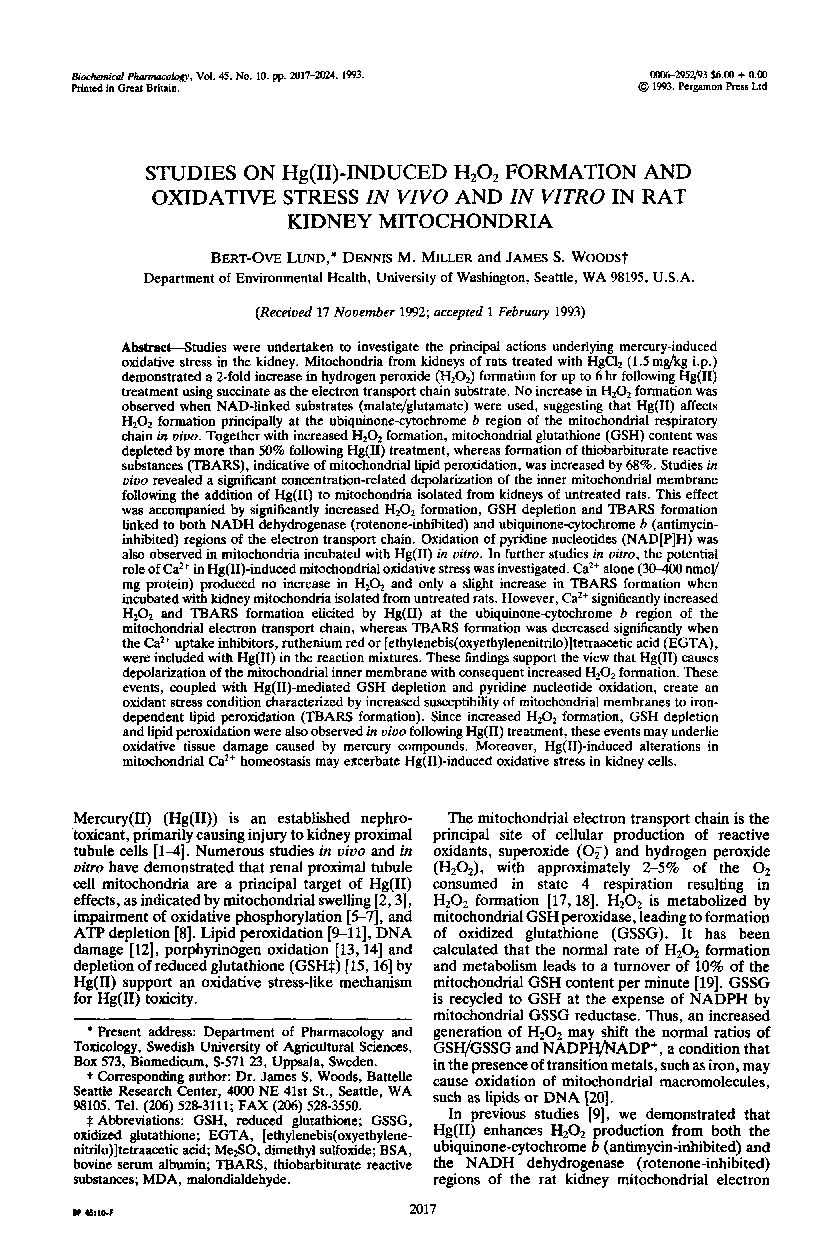| کد مقاله | کد نشریه | سال انتشار | مقاله انگلیسی | نسخه تمام متن |
|---|---|---|---|---|
| 2516462 | 1118862 | 2017 | 8 صفحه PDF | دانلود رایگان |
Studies were undertaken to investigate the principal actions underlying mercury-induced oxidative stress in the kidney. Mitochondria from kidneys of rats treated with HgCl2 (1.5 mg/kg i.p.) demonstrated a 2-fold increase in hydrogen peroxide (H2O2) formation for up to 6 hr following Hg(II) treatment using succinate as the electron transport chain substrate. No increase in H2O2 formation was observed when NAD-linked substrates (malate/glutamate) were used, suggesting that Hg(II) affects H2O2 formation principally at the ubiquinone-cytochrome b region of the mitochondrial respiratory chain in vivo. Together with increased H2O2 formation, mitochondrial glutathione (GSH) content was depleted by more than 50% following Hg(II) treatment, whereas formation of thiobarbiturate reactive substances (TBARS), indicative of mitochondrial lipid peroxidation, was increased by 68%. Studies in vivo revealed a significant concentration-related depolarization of the inner mitochondrial membrane following the addition of Hg(II) to mitochondria isolated from kidneys of untreated rats. This effect was accompanied by significantly increased H2O2 formation, GSH depletion and TBARS formation linked to both NADH dehydrogenase (rotenone-inhibited) and ubiquinone-cytochrome b (antimycin-inhibited) regions of the electron transport chain. Oxidation of pyridine nucleotides (NAD[P]H) was also observed in mitochondria incubated with Hg(II) in vitro. In further studies in vitro, the potential role of Ca2+ in Hg(II)-induced mitochondrial oxidative stress was investigated. Ca2+ alone (30–400 nmol/mg protein) produced no increase in H2O2 and only a slight increase in TBARS formation when incubated with kidney mitochondria isolated from untreated rats. However, Ca2+ significantly increased H2O2 and TBARS formation elicited by Hg(II) at the ubiquinone-cytochrome b region of the mitochondrial electron transport chain, whereas TBARS formation was decreased significantly when the Ca2+ uptake inhibitors, ruthenium red or [ethylenebis(oxyethylenenitrilo)]tetraacetic acid (EGTA), were included with Hg(II) in the reaction mixtures. These findings support the view that Hg(II) causes depolarization of the mitochondrial inner membrane with consequent increased H2O2 formation. These events, coupled with Hg(II)-mediated GSH depletion and pyridine nucleotide oxidation, create an oxidant stress condition characterized by increased susceptibility of mitochondrial membranes to iron- dependent lipid peroxidation (TBARS formation). Since increased H2O2 formation, GSH depletion and lipid peroxidation were also observed in vivo following Hg(II) treatment, these events may underlie oxidative tissue damage caused by mercury compounds. Moreover, Hg(II)-induced alterations in mitochondrial Ca2+ homeostasis may excerbate Hg(II)-induced oxidative stress in kidney cells.
Journal: Biochemical Pharmacology - Volume 45, Issue 10, 25 April 1993, Pages 2017-2024
